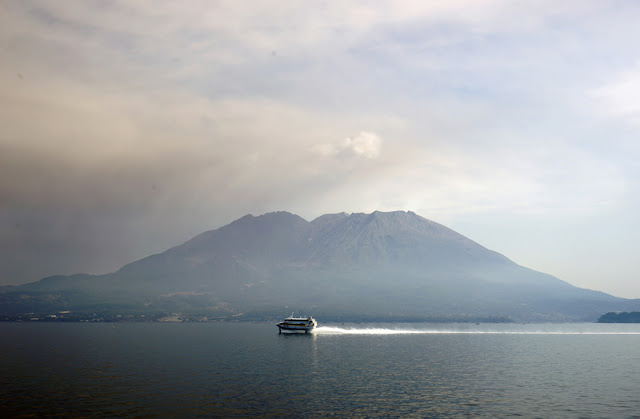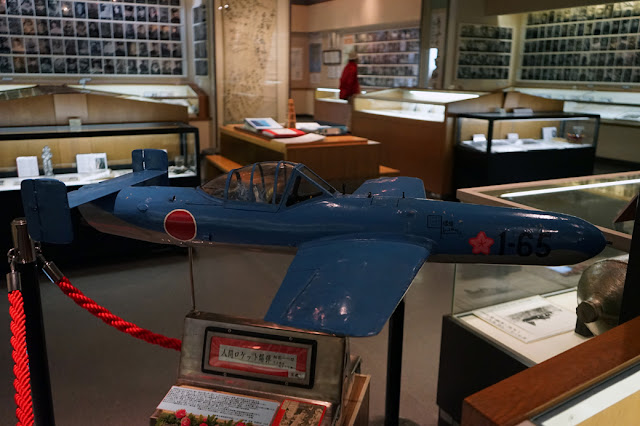 |
| Sakurajima Volcano on Kagoshima Bay |
Saturday, March 28, 2015, based in Kagoshima, the main city of the prefecture to the west of the bay of the same name, I go to visit the KANOYA Naval-Air base museum. It is an important stop in my "Kamikaze" journey. The base was the first takeoff point of the famous Okha human bombs (cherry tree flowers). I will spend the day there. The base is located to the south east of Kagoshima on the other side of the bay. A direct bus (# 16) takes you there and boards on a ferry for the crossing; it is a good opportunity to have a closer look at the active Sakurajima volcano towards the south.
For several days now I had been scrutinizing the volcano eager to perceive one of the sudden daily eruptions. The city of Kagoshima is regularly covered with gray ashes and washed just as often by the many rains that leave black streaks in the streets. It is difficult to sit somewhere without getting dirty. The day before we went to the top of the volcano, but, drowned in the mist, we saw nothing.
This morning the sky is generally clear and Sakura San is peaceful; a big mountain nothing more. On the horizon the ferry crosses the path of the Yukushima hovercraft which “flies” towards the island of the same name, a magical place whose flora inspired Hayaho Misayaki for its anime: Princess Mononoke.
After a one hour and 40 minutes trip I arrive at the base. Cherry trees are just beginning to bloom. On one side is the museum and on the other the operating base of the Japanese self-defense corps that has channeled the warlike energy of Japanese males since the 1945 defeat (Mishima *).

The town of Kanoya is located in a very flat valley surrounded by a wall of mountains bording the coast. The landscape is quite bare, an ideal site for a naval-air base. The museum devotes a large part of its exhibitions to the Jinrai Butai (Thunder Gods) corps , which was stationed at Kanoya, and was composed of bombers and Ohka human bombs. In one of the rooms, a painting depicts the mother plane (nicknamed "Betty") carrying under its belly the missile Ohka. Looking at the picture background we can have a good idea of what the base and the surrounding landscape looked like at the time.
The Ohkas :
The Ohka program was developed to make air suicide missions more effective. Indeed, the Mitsubishi Zero fighter could only reach a speed of 300 to 350 km/h maximum, it remained too vulnerable and easy to defeat by the enemy fleet once the surprise of the first attacks passed.
 |
| Full size Ohka model - Yushukan Museum, Tokyo |
 |
US Personnel conduct a warhead disassembly on a captured Yokosuka
MXY7 Ohka in 1945 (1,200 kg / 2,646 lb ammonal warhead) |
On the contrary, the Ohka with its three rocket engines could reach in dive the speed of 1040 km/hour (650mph)), impossible then to intercept it. Half of the “aircraft” was a 1200 kg (2,646 lb) bomb intended to sink an aircraft carrier. Its defect on the other hand was its poor autonomy, only 37 km of range, it needed a carrier plane (slow) to transport it near the target and fighter planes to protect the squadron. On release, the pilot would first glide towards the target and when close enough he would fire the Ohka's three solid-fuel rockets. I read on one of the websites listed below that the Ohka's cockpit was locked from the outside preventing the pilot from going out. The MXY7 Ohka model 11 (the only one used during the war), 755 sunits built, had a metal fuselage and body and wings made of plywood covered with fabrics, it was equipped summarily with 4 flight instruments. The Japanese had several models under study, one of which could be launched by a catapult from a submarine or a coastal cave.
 |
| Kanoya Air Base, pilotes before a sortie , “Betty” bomber carrying an Ohka Flying Bomb |
Most of Ohka's missions would be directed to the island of Okinawa on April 1945, in all (US sources Wikipedia) 80 "Betty" bombers ,grouped from 2 to 11 aircrafts, would attack the Allies fleet in Okinawa. The day they discovered the first Ohka, the american soldiers nicknamed it Baka (fool), because it was Fool's day … A predestined nickname.
On March 21, 1945, nearly to the day 70 years before my visit, the Japanese Navy launched the first attack of the 321st squadron of the gods of thunder: 18 "Betty" bombers carrying 16 Ohkas human bombs escorted by 30 fighter planes.
 |
| Banzaï ! Paul Abraham, Drawing inspired by a photography of an instructor showing the young student pilots how to crash on the enemy target . |
It was a defeat. The whole squadron was annihilated by the American anti-aircraft defense well before reaching its target. In light of this the Japanese headquarters decided to send smaller groups for the next missions to Okinawa in order to avoid detection. On the whole the program was disastrous, this human bomb had only sunk one American ship and damaged some others, 6 to 7 ships at the most. All Japanese aircraft and crew were destroyed. In total, the Japanese Kamikaze pilots, all means combined, would have sunk 50 Allied ships, when we know that the Allies invasion fleet of Okinawa counted 1400 ships. This gives a success rate of 3.58% ...
 |
| Kanoya Museum Exhibit window - Japanese Navy flag |
 |
| Ohka Model- Kanoya Museum |
 |
| Propaganda Poster- Kanoya Museum |
 |
| Paul Abraham - Water color from Kanoya Museum bronze statue |
The Kanoya Museum exhibits numerous
documents concerning the Ohkas: models, rocket motors, photos and artifacts.
Unfortunately, to see a reproduction of a full size Ohka one must go to the Yushukan
Museum of Tokyo (Picture above). Like the other museums on the subject, many artefacts
that belonged to the pilots, like their farewell letters, are on display. Lets not forget the authentic specimen of the Mitsubishi Zero pride of Japanese
engineering, which thrones in all these museums on a Strategic location. It is also here that one can see some very impressive videos of the young pilots
sortie departures, on the faces of whom you can read despair and fear (see images page of Kaseda). Arriving in the main room I was astonished by the
bronze statue of a very young Kamikaze pilot standing to attention: it reminded
me of a manga character with his western style eyes, his exaggerated Frightened
expression. A young "bishonen" escaped from a Kabuki scene or a
manga for teenagers and lost (It is a bit the feeling that I also felt),
unkempt, pilot goggles crooked, in the middle of this museum glorifying war. Planes, helicopters, seaplanes of the
Japanese self-defense corps, from the 50s to the present day, are exhibited in the surrounding grounds of the
museum. Among these aircrafts there is a curiosity of World War II, a Type 2
seaplane which served as a leading aircraft in bombing missions, carrying 12
crewmen. This plane had been brought back by the Americans to the US to study
it and they had returned it to the Japanese in 1979. (Attached are some images of the plane).
I ended my visit of the museum in the store, buying some souvenirs: a headband
and a cardboard and balsa zero with an elastic thruster ...
 |
| Flying Boat type 2 - Kanoya Museum |
 |
| Aircraft Diagram - Kanoya Museum |
Waiting for the return bus on a bench not far from the base, a Japanese architect was sitting next to me with his grandson. They had came from Fukuoka with the Shikansen for a one-day Museum visit. He spoke English and was astonished to see a Westerner in this remote place. Like all the Japanese encountered, even briefly, he suggests that we pose together for a photo. His grandson was reluctant to serve as the photographer but the architect who had more than one trick in his backpack takes out a tripod and a remote control. The trick is done; "Cheese!"
 |
| Sakurajima Volcano wakes up |
 |
| Back from Yakushima, bay of Kagoshima |
On the ferry back to Kagoshima, surprise! Sakuran San sneezed! A thick cloud of smoke leaves the crater, without noise it piles in the sky, it is impressive. On the other side of the bay, in front of Kagoshima, the Yakushima hydrojet returns to port in the silver light of the ending day.
Video Link: filmed eruption of the volcano from the boat deck, sorry for the sea sickness! https://youtu.be/do0HQndxOnA
* Mishima is summoned by the Japanese army during the Second World War but claims to suffer from tuberculosis, which allows him to escape conscription. Although he was relieved to have escaped the war, he would later feel guilty of surviving and missing the chance of a heroic death. In the 1960s, he expressed strong nationalist ideas. In 1967 he joined Japan's Self-Defense Forces and formed the Tatenokai Private Militia ("Shield Society") to protect the Emperor. Wikipedia.
Sources:
Museum of the Kanoya Naval Air Base
Yushukan Museum of Tokyo
Wikipedia Website ; The Yokosuka MXY-7 Ohka
World War II Database Website
Http://ww2db.com/aircraft_spec.php?aircraft_model_id=379
Kamikazes images Website :




No comments:
Post a Comment
Note: Only a member of this blog may post a comment.